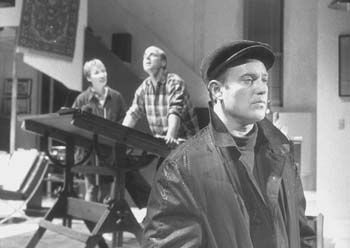Past and Present 'Rain'
Drafting a Memory: Christopher Rich (right), Lorri Holt and Remi Sandi in 'Three Days of Rain.'
Bisected 'Three Days of Rain' at San Jose Rep looks at lives early and late
By Heather Zimmerman
RICHARD GREENBERG'S drama Three Days of Rain offers a literal take on the idea that we eventually "become" our parents. The cast takes on double roles, appearing in the first act, which is set in the present day, as the children of two now-deceased famous architects--and in the second act, which takes place in 1960, as the parents themselves. San José Repertory Theatre offers a strong production of this uniquely structured but ultimately flawed drama.
The small ensemble cast of three turns in excellent performances all around with demanding dual roles that span an emotional spectrum. In the first act, we meet Walker (Remi Sandri) and Nan (Lorri Holt), siblings who are the children of the famous architect Ned Janeway, and Pip (Christopher Rich), the son of Janeway's business partner, Theo Wexler.
The second act, flashing back to 35 years earlier, introduces us to Ned and Theo themselves (Sandri and Rich) and Lina (Holt), the woman who ends up caught between the partners and becomes the mother of Walker and Nan.
Sandri is particularly impressive as the manic, nomadic Walker and as the stuttering, seemingly fragile Ned. Walker's semilunacy is reflected in Holt's touching second-act performance as the emotional and high-strung Lina; by contrast, Holt's Nan is stable but overburdened with balancing the demands of her family and her brother's emotional neediness. As Pip, Rich exudes a happy-go-lucky attitude that sharply contradicts the frustrated genius of his Theo.
Oddly enough, the strengths and weaknesses of Greenberg's script can be summed up by a wonderful technical feat in this production: a simulated downpour with water actually raining onto the stage. It is at once a beautiful touch of realism and a distracting novelty.
Likewise, Greenberg's decision to bisect the play into different time periods provides both an intriguing insight into the powerful influence of the past and a potentially confusing gimmick that leaves too many loose ends, particularly when it comes to the architects' children.
As characters living in the present day, the children ostensibly offer the audience an entrance into the play's intimate and relatively inaccessible world of academia and personal relationships. Unfortunately, Greenberg never really fleshes out the trio of offspring to the point that they really allow such access.
What works best about the juxtaposition of the two generations is how the children perceive, often wrongly, their parents' past actions. As the theories that Nan, Walker and Pip hold about their parents in Act One get disproved by the parents themselves in Act Two, the play explores familial relationships in intriguing fashion. In fact, the play's universal themes of family and love (and the metaphor of architecture as "building" a life together) are more effectively developed in the second act than in the first.
Three Days of Rain mimics architecture--to its advantage and detriment. In making the structure "the thing," the play offers a provocative look at the structures, both literal and figurative, that humans create, from actual buildings to families and marriages. Although it's an apt demonstration of how obsession with social constructs can obscure the individual, Three Days of Rain is perhaps too apt, leaving us stranded in a narrow world that's all about form, saying too little about human function within it.
[ San Jose | Metroactive Central | Archives ]
Copyright © Metro Publishing Inc. Maintained by Boulevards New Media.
![]()

Pat Kirk
Three Days of Rain plays Tuesday-Friday at 8pm, Saturday at 3 and 8pm and Sunday at 2 and 7pm, with an extra show Nov. 18 at noon. The plays runs through Nov. 22. Tickets are $16-$32. (408/291-2255)
From the November 5-11, 1998 issue of Metro.
![[Metroactive Stage]](http://metroactive.com/stage/gifs/stage468.gif)